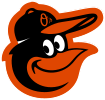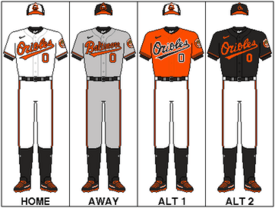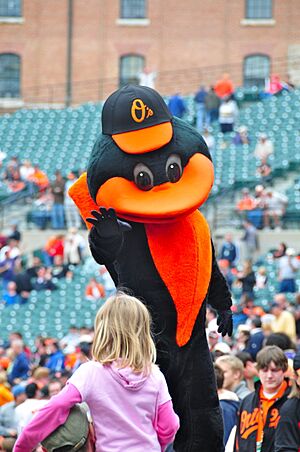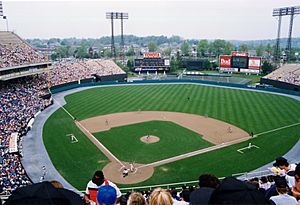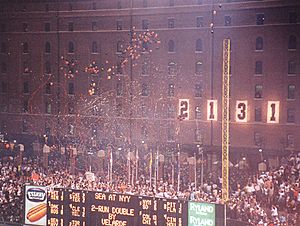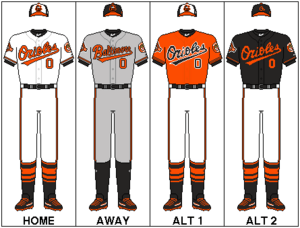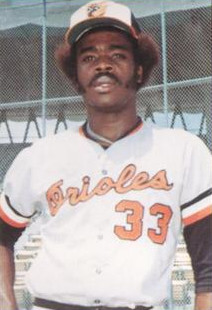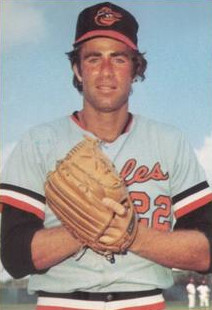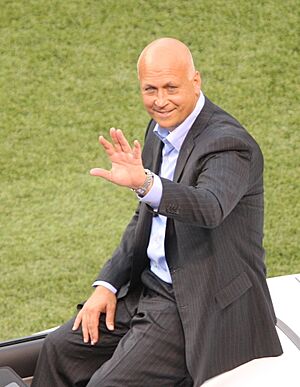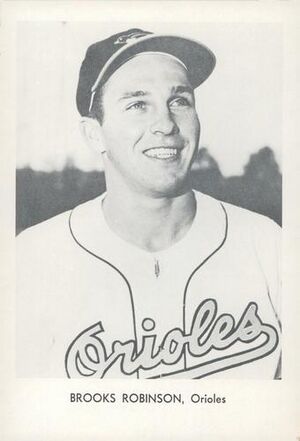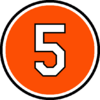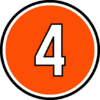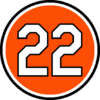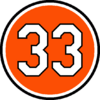Baltimore Orioles facts for kids
Quick facts for kids Baltimore Orioles |
|||
|---|---|---|---|
|
|||
|
|||
| Major league affiliations | |||
|
|||
| Current uniform | |||
| Retired numbers | |||
| Colors | |||
|
|||
| Name | |||
|
|||
| Other nicknames | |||
|
|||
| Ballpark | |||
|
|||
| Major league titles | |||
| World Series titles (3) |
|
||
| AL Pennants (7) |
|
||
| AL East Division titles (9) |
|
||
| Wild card berths (3) |
|
||
| Front office | |||
| Principal owner(s) | Peter Angelos | ||
| President | John P. Angelos (CEO) | ||
| General manager | Mike Elias | ||
| Manager | Brandon Hyde | ||
The Baltimore Orioles are a professional baseball team from Baltimore, Maryland. They play in Major League Baseball (MLB) as part of the American League (AL) East division. The team started in 1901 as the Milwaukee Brewers in Milwaukee, Wisconsin. In 1902, they moved to St. Louis, Missouri, and became the St. Louis Browns.
After 52 years in St. Louis, a group of Baltimore business leaders bought the team in 1953. They renamed the team the Baltimore Orioles. This name honors the official state bird of Maryland. Other baseball teams in Baltimore had used this name before. The team is often called the "O's" or the "Birds."
The Orioles had their most successful years from 1966 to 1983. During this time, they played in the World Series six times and won three championships (in 1966, 1970, and 1983). Many famous players from this era later joined the Hall of Fame. These include Brooks Robinson, Frank Robinson, Jim Palmer, Eddie Murray, Cal Ripken Jr., and manager Earl Weaver.
The Orioles have won nine division titles and seven pennants. They also earned three wild card spots. The team was the last original American League team to win a pennant and a World Series.
After many tough seasons from 1998 to 2011, the Orioles made the playoffs three times. This happened under manager Buck Showalter and general manager Dan Duquette. In 2014, they won their division and reached the American League Championship Series. This was their first time in 17 years. However, in 2018, the team lost 115 games, which was their worst record ever. Showalter and Duquette left the team after that season. Today, Brandon Hyde is the manager, and Mike Elias is the general manager.
The Orioles are also famous for their baseball stadium, Oriole Park at Camden Yards. It opened in 1992 in downtown Baltimore. From 1901 through 2021, the team's overall win-loss record is 8,845 wins and 9,873 losses. Since moving to Baltimore in 1954, their record is 5,466 wins and 5,398 losses through 2022.
Contents
- Team History: From Brewers to Orioles
- Team Uniforms and Logos
- Radio and TV Coverage
- Musical Traditions at Games
- Public Address Announcers
- Playoff Appearances
- Baseball Hall of Famers
- Team Rivalries
- Images for kids
- See also
Team History: From Brewers to Orioles
The Baltimore Orioles team has a long history that started way back in 1877. They were first known as the Milwaukee Brewers. This team was part of the Western League, which later became the American League.
Milwaukee Brewers (1901): A Short Start
In 1901, the Milwaukee Brewers became a major league team. They played their first game against the Detroit Tigers. The Brewers lost 14–13, even after having a big lead. That year, they finished last in the American League. They played their home games at a field called Lloyd Street Grounds.
St. Louis Browns (1902–1953): Moving to Missouri
After just one year, the team moved to St. Louis and became the St. Louis Browns. They had some good years in the 1920s with star player George Sisler. But over time, another team in St. Louis, the St. Louis Cardinals, became more popular and successful.
During World War II, the Browns won their only pennant in 1944. They played in the 1944 World Series against the Cardinals, but lost. By 1953, the Browns were struggling. Their owner, Bill Veeck, tried to move the team back to Milwaukee. But other team owners said no. Instead, Veeck sold the team to a group of Baltimore businessmen.
Baltimore Orioles (1954–Present): A New Beginning
The new owners renamed the team the Baltimore Orioles. This name had been used by other baseball teams in Baltimore for many years. One famous player from an earlier Baltimore Orioles team was Babe Ruth. When their stadium burned down in 1944, that team moved to Municipal Stadium. Their large crowds helped show that Baltimore was a great city for a major league team.
First Years in Baltimore (1954–1965)
It took about six years for the new Orioles team to become strong. Under Paul Richards, who was both manager and general manager, the team slowly got better. Even though they only had one winning season in their first five years, fans loved them. In their first year, over a million people came to watch them play. This was much more than they ever had in Milwaukee or St. Louis.
By the early 1960s, young stars like Brooks Robinson, John "Boog" Powell, and Dave McNally were joining the team. In 1960, the Orioles finished second in the American League. This was the first time they were serious contenders for a championship since 1944. From this point on, the team would have only two losing seasons for the next 26 years!
Golden Era (1966–1983)
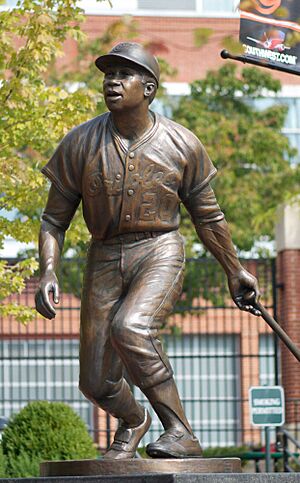
The Orioles' farm system, which develops young players, started producing many talented players and coaches. From 1966 to 1983, the Orioles won three World Series titles and six American League pennants. They also won five of the first six American League East division titles. In 1966, they became the last of the original American League teams to win a World Series.
During this time, the Orioles were known for playing with the Oriole Way. This was a team philosophy about hard work, being professional, and understanding the basics of baseball. It meant that all coaches taught the game the same way. This helped the team always have new players ready to join the main team. This led to the Orioles being the most successful team in baseball during this period.
Many Orioles players won major awards during this time. Frank Robinson (1966), Boog Powell (1970), and Cal Ripken Jr. (1983) were named Most Valuable Player. Four pitchers won the Cy Young Award: Mike Cuellar (1969), Jim Palmer (1973, 1975, 1976), Mike Flanagan (1979), and Steve Stone (1980). Three players were named Rookie of the Year: Al Bumbry (1973), Eddie Murray (1977), and Cal Ripken Jr. (1982).
This was also when "Weaver Ball" became popular, named after manager Earl Weaver. It focused on "Pitching, Defense, and the Three-Run Home Run." As older stars left, new ones like Jim Palmer and Eddie Murray stepped up. The Orioles became very popular, especially as other sports teams left the Baltimore area.
Final Years at Memorial Stadium (1984–1991)
After winning the 1983 World Series, the Orioles had a few tough years. In 1988, they had their worst season ever, losing 107 games and starting with 21 losses in a row. But in 1989, the "Why Not?" Orioles surprised everyone by being in first place for most of the summer. They ended up losing the division title on the last weekend. The next two years were not winning seasons, but Cal Ripken Jr. won his second AL MVP Award in 1991. The team said goodbye to Memorial Stadium, their home for 38 years, at the end of the 1991 season.
Camden Yards Opens and Ripken's Record (1992–1995)
Oriole Park at Camden Yards opened in 1992 and was an instant hit. Its classic design inspired many other new baseball stadiums. The Orioles played well in their first two seasons there, finishing in third place both times.
In 1993, Peter Angelos, a lawyer from Baltimore, led a group to buy the Orioles. This brought the team back to local ownership. In 1994, a players' strike stopped the season early. The Orioles were in second place when it happened.
The strike continued into 1995. Most teams used "replacement players" for spring training, but the Orioles did not. Their owner, Peter Angelos, was a lawyer for labor unions. This decision protected Cal Ripken Jr.'s amazing streak of playing in every game. The strike ended, and Ripken continued his streak. On September 6, 1995, he broke Lou Gehrig's record of 2,130 consecutive games played. This moment was voted the best baseball moment of the 20th century. Ripken's streak finally ended on September 20, 1998, after 2,632 straight games.
Playoff Years (1996–1997)
Before the 1996 season, the Orioles hired Pat Gillick as general manager. He signed many talented players like Roberto Alomar. Under new manager Davey Johnson, the Orioles hit a record 257 home runs and made the playoffs for the first time in 12 years. They won their first playoff series but lost to the New York Yankees in the next round. A controversial play where a fan interfered with a ball helped the Yankees win one game.
In 1997, the Orioles led their division from start to finish. They won another playoff series but lost again in the next round, this time to the Cleveland Indians. Manager Davey Johnson resigned after the season due to disagreements with owner Peter Angelos.
Tough Times (1998–2011)
After 1997, the Orioles had many losing seasons. They struggled to find good managers and general managers. The team also faced new competition when the Washington Nationals moved to nearby Washington, D.C., in 2004. This caused a dispute between the Orioles owner and Major League Baseball over money.
In 2007, Andy MacPhail became the new President of Baseball Operations. He made some big trades, sending away star players for younger talent. One important trade sent pitcher Érik Bédard to Seattle for players like Adam Jones and Chris Tillman. These players would become key to the Orioles' future success.
Even with these changes, the team continued to struggle. They never finished higher than fourth place in their division. In 2010, Buck Showalter was hired as manager. The team played much better under him, giving fans hope. In 2011, the Orioles tried to improve by bringing in more experienced players. But their pitching staff had a very tough year. After the 2011 season, Dan Duquette became the new Executive Vice-President of Baseball Operations.
Return to Success (2012–2016)
Duquette quickly changed the team, especially the pitching staff. He traded for Jason Hammel and signed new pitchers like Wei-Yin Chen. Young star Manny Machado also made his debut.
The Orioles won 93 games in 2012, a huge improvement from the year before. Their bullpen (relief pitchers) was amazing, led by Jim Johnson with 51 saves. The team won many close games and extra-inning games. They earned a playoff spot for the first time in 15 years. They won the Wild Card game against the Texas Rangers but lost to the New York Yankees in the next round.
In 2013, the Orioles had another winning season. In 2014, they won their division for the first time since 1997. They swept the Detroit Tigers in the first playoff round but were then swept by the Kansas City Royals.
In 2015, some games were postponed or played without fans due to protests in Baltimore. This was a very rare event in baseball history. In 2016, the Orioles made the Wild Card game again but lost to the Toronto Blue Jays.
Recent Years (2017–Present)
After 2016, the Orioles had more losing seasons. In 2018, they lost 115 games, one of the worst seasons in team history. Manager Buck Showalter and general manager Dan Duquette left the team.
The Orioles began to rebuild their team, trading away many popular players. In 2019, they lost 108 games. In 2020, the season was shorter due to the COVID-19 pandemic, and the Orioles showed some improvement. But in 2021, they had another very tough year, losing 110 games.
In 2022, there was a family disagreement about who should control the team. The owner, Peter Angelos, had health issues. His son, Louis Angelos, filed a lawsuit claiming his brother, John P. Angelos, and mother were not following their father's wishes for the team's ownership. The family members involved have denied these claims.
Team Uniforms and Logos
The Orioles' home uniform is white with "Orioles" written across the chest. Their away uniform is gray with "Baltimore" written across the chest. These styles have been used for most of the team's history, with some changes over the years.
- From 1963 to 1965, the home uniforms had "Orioles" in block letters instead of the usual cursive writing.
- The underline below "Orioles" was removed from 1966 to 1988.
- For many years, the away uniforms did not say "Baltimore" on them. Fans wanted the city name back, and it returned in the 1970s.
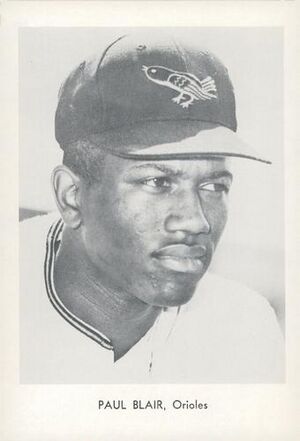
The Orioles also have an alternate black uniform with "Orioles" across the chest. They started wearing black uniforms in 1993. They often wear them for Friday night games.
Orange alternate uniforms have also been used at different times. The first orange uniforms were worn in 1971 with orange pants. In 2012, the Orioles brought back orange uniforms as a second alternate. They often wear them on Saturdays.
The Orioles' cap designs have changed between a "cartoon bird" logo and a full-bodied bird logo. The full-bodied bird was used from 1954 to 1965. The "cartoon bird" first appeared in 1966 and was on the caps until 1988. In 2012, a modern version of the "cartoon bird" returned to the caps.
In 2013, ESPN held a "Battle of the Uniforms" contest, and the Orioles' uniforms were voted the best among all Major League teams.
Radio and TV Coverage
Radio Broadcasts
In Baltimore, you can hear Orioles games on WBAL-AM and WIYY radio stations. Geoff Arnold, Melanie Newman, Brett Hollander, Scott Garceau, and Kevin Brown take turns describing the games. WBAL sends the games to many other stations across several states.
Many former Orioles radio announcers have received special awards for their great broadcasting. These include Chuck Thompson, Jon Miller, Ernie Harwell, and Harry Caray.
Television Broadcasts
MASN (Mid-Atlantic Sports Network) is the main TV channel for Orioles games. It is partly owned by the Orioles. MASN shows almost all regular season games. Sometimes, games are shown on Fox or ESPN.
Gary Thorne was the main TV announcer from 2007 to 2019. Jim Palmer, a Hall of Fame pitcher, and former player Mike Bordick are also often on the broadcasts. In 2021, MASN made some changes to its broadcast team. Starting in 2022, Kevin Brown became the main TV play-by-play announcer.
The Orioles and the Washington Nationals (another baseball team) have had a disagreement about money related to MASN. The Orioles own 80% of MASN.
Musical Traditions at Games
The "O!" Chant
Since the late 1970s, fans at Orioles games have had a special tradition. During the line "Oh, say does that Star-Spangled Banner yet wave" in the "The Star-Spangled Banner" (the U.S. national anthem), fans yell out the "Oh." This tradition is very important in Baltimore because the anthem was written there during the War of 1812.
This "O!" chant is also common at other sports events in the Baltimore/Washington area. It was even heard when Cal Ripken Jr. was inducted into the Hall of Fame.
"Thank God I'm a Country Boy"
Since 1975, the Orioles have played John Denver's song "Thank God I'm a Country Boy" during the seventh-inning stretch of every home game. This tradition started in August 1975 as a good luck charm when the team was doing well.
John Denver himself danced to the song on the Orioles' dugout in 1997, shortly before he passed away.
Other Songs and Traditions
- "Orioles Magic (Feel It Happen)": This team song used to be played when the team ran onto the field. Now, it is played after the Orioles win a game.
- "Seven Nation Army": This song is played to get fans excited, and they often chant along to its famous bass riff.
- The First Army Band: At the last home game of the season, the United States Army Field Band from Fort Meade performs the National Anthem. They are called the "First Army Band."
Public Address Announcers
For 23 years, Rex Barney was the voice of the Orioles as the PA announcer. His voice was famous at both Memorial Stadium and Camden Yards. He was known for saying "Give that fan a contract" when a fan caught a foul ball. Rex Barney passed away in 1997.
After him, Dave McGowan was the PA announcer until 2011. Then, Ryan Wagner took over. As of the 2022 season, Adrienne Roberson is the current Orioles PA announcer.
Playoff Appearances
The Orioles were the last of the eight original American League teams to win the World Series. They did this in 1966 by beating the Los Angeles Dodgers. When the team was the St. Louis Browns, they played in one World Series in 1944 but lost.
The Orioles won the first-ever American League Championship Series in 1969. In 2012, they won the first American League Wild Card game where two Wild Card teams played each other.
| Year | Wild Card Game | ALDS | ALCS | World Series | ||||
|---|---|---|---|---|---|---|---|---|
| 1944 | Not played | St. Louis Cardinals | L | |||||
| 1966 | Not played | Los Angeles Dodgers | W | |||||
| 1969 | Not played | Minnesota Twins | W | New York Mets | L | |||
| 1970 | Not played | Minnesota Twins | W | Cincinnati Reds | W | |||
| 1971 | Not played | Oakland Athletics | W | Pittsburgh Pirates | L | |||
| 1973 | Not played | Oakland Athletics | L | |||||
| 1974 | Not played | Oakland Athletics | L | |||||
| 1979 | Not played | California Angels | W | Pittsburgh Pirates | L | |||
| 1983 | Not played | Chicago White Sox | W | Philadelphia Phillies | W | |||
| 1996 | Not played | Cleveland Indians | W | New York Yankees | L | |||
| 1997 | Not played | Seattle Mariners | W | Cleveland Indians | L | |||
| 2012 | Texas Rangers | W | New York Yankees | L | ||||
| 2014 | Bye | Detroit Tigers | W | Kansas City Royals | L | |||
| 2016 | Toronto Blue Jays | L | ||||||
Baseball Hall of Famers
Many players and managers who were part of the Orioles or St. Louis Browns have been inducted into the National Baseball Hall of Fame. These include:
- Milwaukee Brewers: Hugh Duffy
- St. Louis Browns: Jim Bottomley, Willard Brown, Jesse Burkett, Dizzy Dean, Rick Ferrell, Goose Goslin, Rogers Hornsby, Heinie Manush, Satchel Paige, Eddie Plank, Branch Rickey, George Sisler, Bill Veeck, Rube Waddell, Bobby Wallace
- Baltimore Orioles: Roberto Alomar, Luis Aparicio, Harold Baines, Vladimir Guerrero, Whitey Herzog, Reggie Jackson, George Kell, Eddie Murray, Mike Mussina, Jim Palmer, Tim Raines, Cal Ripken Jr., Robin Roberts, Brooks Robinson, Frank Robinson, Lee Smith, Jim Thome, Earl Weaver, Hoyt Wilhelm, Dick Williams
Retired Numbers
The Orioles retire a player's number when they are inducted into the Hall of Fame, with Cal Ripken Jr. being a special exception. The team has retired these numbers:
|
- Note: The numbers 7 (for Cal Ripken Sr.), 44 (for Elrod Hendricks), and 46 (for Mike Flanagan) are not officially retired. However, the team has not given these numbers to new players since these individuals passed away.
- †Jackie Robinson's number 42 is retired across all of Major League Baseball.
Baltimore Orioles Hall of Fame
The Orioles also have their own team Hall of Fame. It is located at Camden Yards. The most recent person inducted was fan Mo Gaba in 2020.
Team Rivalries
The Orioles have a growing rivalry with the nearby Washington Nationals. This is called the Beltway Series. Baltimore currently has a better record against the Nationals.
The Orioles also have a long-standing rivalry with the New York Yankees. This rivalry goes back to when both teams were formed. Yankees legend Babe Ruth was from Baltimore. Also, Cal Ripken Jr. broke Lou Gehrig's record for most consecutive games played, which added to the rivalry.
In recent years, the Orioles have also had rivalries with other teams in their division, like the Boston Red Sox and the Toronto Blue Jays. In 2016, the Blue Jays ended the Orioles' playoff hopes in a game where a fan threw a can at an Orioles player. There have been other heated moments between these two teams.
Images for kids
See also
 In Spanish: Baltimore Orioles para niños
In Spanish: Baltimore Orioles para niños


